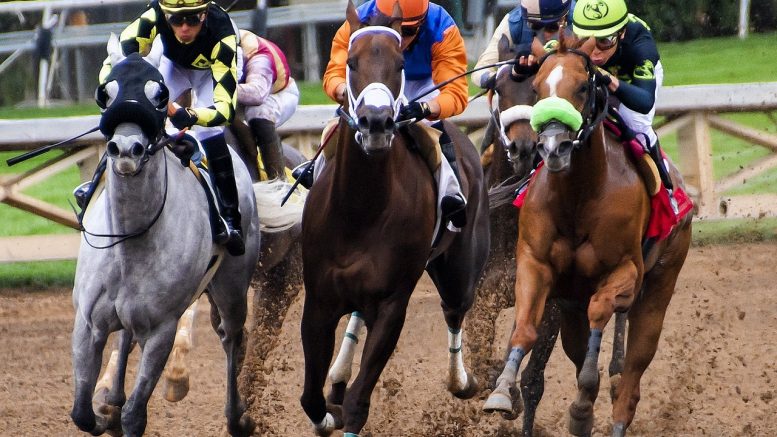by Fed Up Texas Chick, The Tenpenny Report:

By late May 2023, twelve horses had mysteriously died at the famous Churchill Downs racetrack, home of the Kentucky Derby. This unusually high number of deaths prompted immediate emergency race official meetings.
The Horseracing Integrity and Safety Authority (HISA) as well as the Kentucky Horse Racing Commission (KHRC), organizations responsible for horse and rider safety, vowed to investigate the matter.
Seven horses died in the week before the May 6 Kentucky Derby, the 149th race in its history. Two died after sustaining injuries at the Derby and two more in the weeks that followed. The last horse died the last week of May.
TRUTH LIVES on at https://sgtreport.tv/
This was a prominent May story, with particular focus on the seven horses that died in the one-month period leading up to the race. The deaths fueled outrage from animal activists and brought the limelight of scrutiny back to the sport.
 A Lucrative Industry
A Lucrative Industry
Horse racing is a lucrative industry. While many owners and trainers profess that the horses get the utmost in care, some in the industry take advantage of “the edge”. Longstanding rumors abound about animal doping, particularly among Triple Crown winners. The 2023 Derby deaths are not a first-time event. In 2019, more than 30 horses died in one racing season at California’s Santa Anita Park. In 2021, Kentucky Derby winner Medina Spirit’s win was a long shot. Later, the three-year-old colt was disqualified and stripped of his title after failing a post-derby drug test. Trainer Bob Baffert was suspended as well, amassing a record of 74 horses which died under his care since 2000.
Medina Spirit died in December 2021 from an apparent cardiac event after a routine workout at the Santa Anita racetrack.
What killed Medina Spirit? The horse tested positive for betamethasone, a steroid used to reduce inflammation and pain. While it is a drug allowed in therapy, betamethasone cannot be present in the blood on race day because it is a performance booster. Baffert claimed that ointment and not injections were used to treat skin fungus, and also claimed that the small amount detected had no effect on performance.
Veterinary experts say that long-term betamethasone use can negatively affect a horse’s adrenal glands. While the drug doesn’t build up in the body like other steroids, it can cause the body to produce lower cortisol levels resulting in weight loss, muscle weakness and fatigue. The drug is typically used for mere days, but Baffert’s team used in for at least a month. In Medina Spirit’s case, however, it is unlikely that betamethasone played a role in the horse’s death.
Common causes of death are fractured limbs or neck, viruses and toxic substances. Postmortem autopsies help determine the cause of death in only about half of all cases.
In Medina Spirit’s case, the report showed signs of excessive exercise. Many claimed that Medina Spirit was too young to race. A horse’s bones do not reach musculoskeletal maturity until age six. The bones of the neck and spine are the last to mature, yet most racehorses train intensively at 18 months of age and race by age 2, the equivalent age of a 6-year-old child.

A History of Doping
Doping scandals have persisted in an industry bent on winning at all costs. In 2020, 27 people were indicted for giving racehorses performance-enhancing drugs. Trainer Jason Servis doped all his horses, including 2019 Kentucky Derby winner Maximum Security, later disqualified.
What is interesting about this shakedown is that everyone – trainers, veterinarians, and drug distributors – was involved, many the most prominent in their respective fields.
The drugs knowingly were given to increase the animal’s performance beyond natural abilities. Drugs were used that relieved pain and inflammation, increased stamina and endurance, and even increased red blood cell count. A drug known as “epo”, short for erythropoietin, boosts a horse’s red blood cell count to increase endurance on the track. If you’re a cycling fan, epo is the same drug used by Lance Armstrong, who famously said he could never have won the Tour de France seven times “clean”.
The drugs were secretly administered to the horses, with the whole supply chain (so to speak) of people involved to keep the secrets, evade the rules and simply look the other way. Many of the horses of the 2020 indictment experienced cardiac issues and increased risk of injury due to overexertion, particularly leg fractures. One trainer was even accused of quietly disposing of dead horses rather than reporting the deaths to the authorities.
In 2021, Congress tasked a new federal agency, the Horseracing Integrity and Safety Authority (HISA), with anti-doping control. HISA has been in operation for about a year now, and more stringent rules are apparently on the way. Many complain about the lax current rules, such as allowing a violator in one state to race in a different state.
The industry would prefer that HISA did not exist, and several organizations filed so many lawsuits against HISA that the organization was effectively prevented from doing anything about doping until May 2023, too late to make a difference in the 2023 Derby. HISA has been performing other duties, such as ensuring required vaccines before horses enter a racetrack. Required vaccines are encephalitides, rabies, tetanus, influenza and rhinopneumonitis.
Owners question whether HISA will be more burdensome than beneficial, and let’s face it, that’s the question most of us have about our federal agencies. Like many federal agencies, HISA collects fees. Amounts vary widely by state, but California pays about $1.4 million. Many suspect that HISA will cause the demise of many smaller racetracks who can’t keep up with the fees.
Was HISA Helpful?
When this year’s Derby was in the spotlight, all the right authorities said all the right things: “we will rigorously understand what caused these incidents”. The University of Kentucky was tasked with conducting postmortems on each horse, and the racehorse groups ensured the public of their utmost commitment to the animals’ health and safety. Despite the deaths, racing resumed on June 1, with Churchill Downs adopting more rigorous safety measures as the investigation continued.
Despite the fact that HISA, KHRC and Churchill Downs are all conducting separate investigations, we still don’t know what happened. What’s taking so long? The spring racing season has just concluded with another horse death. Despite finding no issues with the Churchill Downs track, racing was moved to nearby Ellis Park, yet on June 24, a 3-year-old gelding (I’m a Modest Man) suffered a catastrophic leg injury and was euthanized.
All the deaths are deemed unique as some raced on a dirt track while others were on a turf track. One death was a paddock accident and two were sudden deaths.
Read More @ TheTenpennyReport.com



